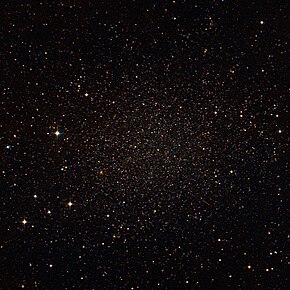
A globular cluster is a spheroidal conglomeration of stars that is bound together by gravity, with a higher concentration of stars towards their centers. They can contain anywhere from tens of thousands to many millions of member stars, all orbiting in a stable, compact formation. Globular clusters are similar in form to dwarf spheroidal galaxies, and the distinction between the two is not always clear. Their name is derived from Latin globulus. Globular clusters are occasionally known simply as "globulars".

The Local Group is the galaxy group that includes the Milky Way. It has a total diameter of roughly 3 megaparsecs (10 million light-years; 9×1019 kilometres), and a total mass of the order of 2×1012 solar masses (4×1042 kg). It consists of two collections of galaxies in a "dumbbell" shape; the Milky Way and its satellites form one lobe, and the Andromeda Galaxy and its satellites constitute the other. The two collections are separated by about 800 kiloparsecs (3×10^6 ly; 2×1019 km) and are moving toward one another with a velocity of 123 km/s. The group itself is a part of the larger Virgo Supercluster, which may be a part of the Laniakea Supercluster. The exact number of galaxies in the Local Group is unknown as some are occluded by the Milky Way; however, at least 80 members are known, most of which are dwarf galaxies.

The Sagittarius Dwarf Spheroidal Galaxy (Sgr dSph), also known as the Sagittarius Dwarf Elliptical Galaxy, is an elliptical loop-shaped satellite galaxy of the Milky Way. It contains four globular clusters in its main body, with the brightest of them—NGC 6715 (M54)—being known well before the discovery of the galaxy itself in 1994. Sgr dSph is roughly 10,000 light-years in diameter, and is currently about 70,000 light-years from Earth, travelling in a polar orbit at a distance of about 50,000 light-years from the core of the Milky Way. In its looping, spiraling path, it has passed through the plane of the Milky Way several times in the past. In 2018 the Gaia project of the European Space Agency showed that Sgr dSph had caused perturbations in a set of stars near the Milky Way's core, causing unexpected rippling movements of the stars triggered when it moved past the Milky Way between 300 and 900 million years ago.

The Pegasus Dwarf Spheroidal is a dwarf spheroidal galaxy about 2.7 million light-years away in the constellation Pegasus. The Pegasus Dwarf is a member of the Local Group and a satellite galaxy of the Andromeda Galaxy (M31).

A dwarf galaxy is a small galaxy composed of about 1000 up to several billion stars, as compared to the Milky Way's 200–400 billion stars. The Large Magellanic Cloud, which closely orbits the Milky Way and contains over 30 billion stars, is sometimes classified as a dwarf galaxy; others consider it a full-fledged galaxy. Dwarf galaxies' formation and activity are thought to be heavily influenced by interactions with larger galaxies. Astronomers identify numerous types of dwarf galaxies, based on their shape and composition.

The Centaurus A/M83 Group is a complex group of galaxies in the constellations Hydra, Centaurus, and Virgo. The group may be roughly divided into two subgroups. The Cen A Subgroup, at a distance of 11.9 Mly, is centered on Centaurus A, a nearby radio galaxy. The M83 Subgroup, at a distance of 14.9 Mly, is centered on the Messier 83 (M83), a face-on spiral galaxy.
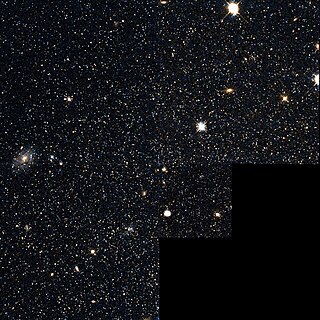
Andromeda I is a dwarf spheroidal galaxy (dSph) about 2.40 million light-years away in the constellation Andromeda. Andromeda I is part of the local group of galaxies and a satellite galaxy of the Andromeda Galaxy (M31). It is roughly 3.5 degrees south and slightly east of M31. As of 2005, it is the closest known dSph companion to M31 at an estimated projected distance of ~40 kpc or ~150,000 light-years.
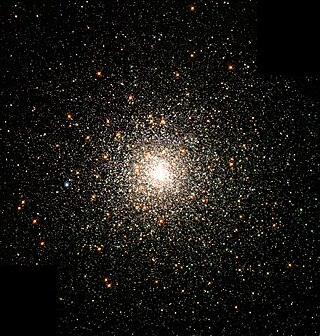
In astronomy, metallicity is the abundance of elements present in an object that are heavier than hydrogen and helium. Most of the normal currently detectable matter in the universe is either hydrogen or helium, and astronomers use the word "metals" as a convenient short term for "all elements except hydrogen and helium". This word-use is distinct from the conventional chemical or physical definition of a metal as an electrically conducting solid. Stars and nebulae with relatively high abundances of heavier elements are called "metal-rich" in astrophysical terms, even though many of those elements are nonmetals in chemistry.
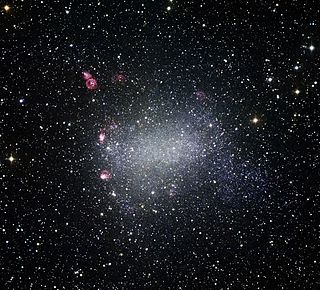
NGC 6822 is a barred irregular galaxy approximately 1.6 million light-years away in the constellation Sagittarius. Part of the Local Group of galaxies, it was discovered by E. E. Barnard in 1884, with a six-inch refractor telescope. It is the closest non-satellite galaxy to the Milky Way, but lies just outside its virial radius. It is similar in structure and composition to the Small Magellanic Cloud. It is about 7,000 light-years in diameter.
The Sextans Dwarf Spheroidal is a dwarf spheroidal galaxy that was discovered in 1990 by Mike Irwin as the 8th satellite of the Milky Way, located in the constellation of Sextans. It is also an elliptical galaxy, and displays a redshift because it is receding from the Sun at 224 km/s. The distance to the galaxy is 320,000 light-years and the diameter is 8,400 light-years along its major axis.

The Draco Dwarf is a spheroidal galaxy which was discovered by Albert George Wilson of Lowell Observatory in 1954 on photographic plates of the National Geographic Society's Palomar Observatory Sky Survey (POSS). It is part of the Local Group and a satellite galaxy of the Milky Way galaxy. The Draco Dwarf is situated in the direction of the Draco Constellation at 34.6° above the galactic plane.

The Fornax Dwarf Spheroidal is an elliptical dwarf galaxy in the constellation Fornax that was discovered in 1938 by Harlow Shapley. He discovered it while he was in South Africa on photographic plates taken by the 24 inch (61 cm) Bruce refractor at Boyden Observatory, shortly after he discovered the Sculptor Dwarf Galaxy.

Andromeda II is a dwarf spheroidal galaxy about 2.22 Mly away in the constellation Pisces. While part of the Local Group, it is not quite clear if it is a satellite of the Andromeda Galaxy or the Triangulum Galaxy.

Leo II is a dwarf spheroidal galaxy about 690,000 light-years away in the constellation Leo. It is one of 24 known satellite galaxies of the Milky Way. Leo II is thought to have a core radius of 178 ± 13 pc and a tidal radius of 632 ± 32 pc. It was discovered in 1950 by Robert George Harrington and Albert George Wilson, from the Mount Wilson and Palomar Observatories in California.
Canes Venatici I or CVn I is a dwarf spheroidal galaxy situated in the Canes Venatici constellation and discovered in 2006 in the data obtained by Sloan Digital Sky Survey. It is one of the most distant known satellites of the Milky Way as of 2011 together with Leo I and Leo II. The galaxy is located at a distance of about 220 kpc from the Sun and is moving away from the Sun at a velocity of about 31 km/s. It is classified as a dwarf spheroidal galaxy (dSph) meaning that it has an elliptical shape with the half-light radius of about 550 pc.
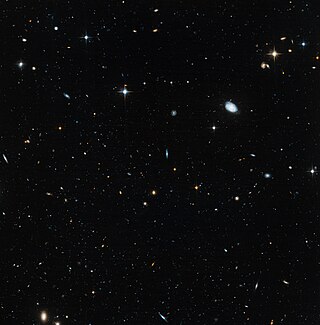
Leo IV is a dwarf spheroidal galaxy situated in the Leo constellation, discovered in 2006 in the data obtained by the Sloan Digital Sky Survey. The galaxy is located at the distance of about 160 kpc from the Sun and moves away from the Sun with the velocity of about 130 km/s. It is classified as a dwarf spheroidal galaxy (dSph) meaning that it has an approximately round shape with the half-light radius of about 130 pc.

Hercules, or Her, is a dwarf spheroidal galaxy situated in the Hercules constellation and discovered in 2006 in data obtained by the Sloan Digital Sky Survey. The galaxy is located at a distance of about 140 kpc from the Sun and moves away from the Sun with a velocity of about 45 km/s. It is classified as a dwarf spheroidal galaxy (dSph). It has a noticeably elongated shape with a half-light radius of about 350 pc. This elongation may be caused by tidal forces acting from the Milky Way galaxy, meaning that Her is being tidally disrupted now. Her also shows some gradient of velocities across the galaxy's body and is embedded into a faint stellar stream, which also points towards its ongoing tidal disruption.

The Gaia Sausage or Gaia Enceladus is the remains of a dwarf galaxy that merged with the Milky Way about 8–11 billion years ago. At least eight globular clusters were added to the Milky Way along with 50 billion solar masses of stars, gas and dark matter. It represents the last major merger of the Milky Way.

DDO 44 is a dwarf spheroidal galaxy in the M81 Group, believed to be a satellite galaxy of the nearby NGC 2403.
